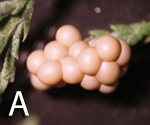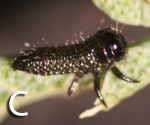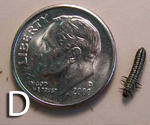Tamarisk Biocontrol
The Tamarisk beetle program is NOT available to the public.
Government and Institutional customers by special request only. Please contact Nina Louden at nina.louden@state.co.us.
What is Tamarisk?
Tamarisk or salt cedar, is an invasive tree in the United States belonging to the family Tamaricaceae. Although eight species have been introduced into North America, Tamarix chinensis and Tamarix ramosissima along with their hybridized form make up the bulk of the invasion in the southwestern U.S. These species were brought to the country in the early 1800s as ornamentals and for use as windbreaks and erosion control.
How to Identify Tamarisk?
Tamarisk ranges in size from three to 20 feet tall. It is generally considered a shrub or small tree. In Colorado, it typically begins to flower by April with pink to white blooms. It is a deciduous tree in Colorado with small scaly leaves 1/16 of an inch in size. The leaves overlap resembling cedar or juniper though they are often encrusted with salt. Salt is released by way of specialized glands that aid in tolerating highly saline soils.
Effects of Tamarisk
Like other invasive species, tamarisk is able to form a thick monoculture by outcompeting native plants. It is well adapted to grow in disturbed habitats where other plant species cannot tolerate poor soil conditions or drought. It has been estimated to spread up to 12 miles downstream a year and water use by an individual tamarisk tree can be as much as 20 gallons per day by way of an extensive creeping taproot.
Biological Control
There are several species of leaf beetles belonging to the genus Diorhabda that are useful as biological control agents in the U.S. These species are endemic to varying locations throughout Eurasia. In Colorado, the northern tamarisk beetle (Diorhabda carinulata) is currently established and responsible for defoliating or browning of tamarisk canopies in regions throughout the state. The northern tamarisk beetle was released in western Colorado in 2005. Since this time beetle numbers have grown substantially even in eastern Colorado where tamarisk infestations encompass far greater acreage. The Insectary continues to release beetles in regions of the state where tamarisk establishment has not been as successful. Currently, repeat defoliation events have resulted in instances of tree mortality and significant dead tamarisk biomass in western Colorado.
Life Stages of the Tamarisk beetle
Tamarisk beetles develop through three instar or larval stages before pupation (A-E). Growing larvae produce the greatest damage to tamarisk resulting from feeding throughout the tree’s canopy in large numbers. Males exude an attractant pheromone promoting aggregation and mass egg lay on selected trees (F). Development time from larva to adult takes roughly 28 days with late summer adults overwintering in plant debris under tamarisk. Adult emergence in spring takes place by mid to late April as deciduous tamarisk sends out new leaves.






FAQ
How does the beetle damage tamarisk and will they kill it?
Feeding damage by larvae and adult beetles occurs because the insect scrapes tissue from tamarisk leaves resulting in desiccation and browning of the foliage. Death to part of the tree’s foliage or even the entire leaf canopy may result in tree mortality following two to three consecutive defoliations. Tree mortality ranges from 0-52% at monitored sites in western CO that have been defoliated multiple times. Eradication is not the goal of biocontrol. Instead, control over further spread of the invasive is of primary importance. Even at sites where no tree mortality has been observed, reducing the density and vigor of tamarisk provides greater availability of resources for other species resulting in better ecosystem health.
What else will tamarisk beetles attack?
Tamarisk beetles are specialists for tamarisk. Like other biocontrol agents, they have co-evolved with their host and have been rigorously tested on other plant species before release. Any risk a biocontrol may pose to native species in the U.S. is thoroughly reviewed and assessed by USDA scientists and other researchers for 10-20 years before open field release occurs.
How do I order and apply beetles?
Tamarisk beetles are not available to the public. The tamarisk program is only available to government and institutional customers by special request.